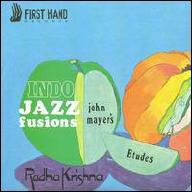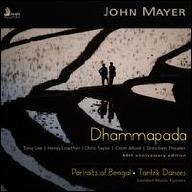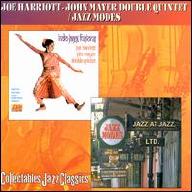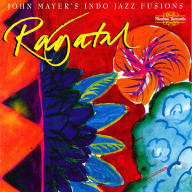Born in 1930 in Calcuttato an Anglo-Indian father and an Indian mother, Mayer was born in 1930, his musical interests manifesting themselves early, and at seven he was studying violin with Phillipe Sandre at the Calcutta School of Music, who agreed to teach him in his free time, because Mayer's parents lacked the resources to send him there as a paying pupil. He later studied with Melhi Metha, who encouraged him, while in his late teens, to compete for a scholarship to the Royal Academy of Music in London. By then, Mayer was determined to become a composer who would be taken seriously both in his own country and abroad. He also wanted to achieve this utilizing both European and Indian techniques, and toward this end he studied with Sanathan Mukherjee, who taught him the theoretical aspects of Indian classical music. At the time, he knew and heard little of jazz, although he did start sitting in as a drummer with jazz bands. Mayer won the scholarship, and arrived in London in 1950 to study at the Royal Academy. He had won through his violin playing, but he started out studying composition with Matyas Sether, who encouraged him to use the techniques of Indian and western music in serial composition. His money ran out after only a year, but he was fortunate enough to earn a spot in the violin section of the London Philharmonic Orchestra. Thus began a somewhat awkward eight-year period in which he played in the violin section of the orchestra while continuing to study composition -- despite having some of his works played by the orchestra, and conducted by Sir Adrian Boult, he didn't begin to make headway as a composer until Sir Charles Groves commissioned him to write his Dance Suite for sitar, flute, tabla, tambura, and symphony orchestra, which was premiered by the Royal Liverpool Philharmonic Orchestra in 1958. This early success, however, created problems with the management of the London Philharmonic, however, which was a conservative organization and didn't appreciate having a composer within the ranks of its performing musicians. Mayer was forced to leave his job at the LPO, but was hired by the Royal Philharmonic Orchestra, under the direction of Sir Thomas Beecham, who asked him to join. Mayer began a happy seven-year relationship with the RPO, in the process learning a huge amount about orchestration (as well as conducting) from some of the finest players in England. By 1965, when he left the RPO's violin section, he was able to finally earn his living from his compositions and to quit full-time orchestral playing. Additionally, by that time, fate had taken a hand in his career -- Mayer was known in avant-garde London circles for his work mixing western and Hindustani classical music, and in 1964, EMI producer Dennis Preston asked him if he had available a short jazz-based piece with which to complete an album Preston was working on. Mayer told him he did, even though he had nothing ready -- Preston said he wanted to record it the next day, and Mayer stayed up all night writing the piece. He attended the recording the following day, and thought no more about it until six months later when Preston told him that he'd played the piece to Atlantic Records founder and president Ahmet Ertegun in New York, who'd liked what he'd heard and suggested that Mayer write music for an album which would fuse Indian music and jazz. Ertegun's idea was to combine the quintet of Indian musicians with whom Mayer worked, featuring a sitar, tabla, tambura, flute, with Mayer on violin and harpsichord, and a jazz quintet led by Joe Harriott, himself an under-appreciated alto player who had shown an appreciation of various aspects of world music. Mayer wrote the music in a month, and it was recorded by this group, known as the Joe Harriott John Mayer Double Quintet, in two days. The resulting album, Indo-Jazz Fusions, was released in 1966 and became an immediate favorite in avant-garde circles and an unexpectedly good seller. Additionally, the group ended up not only in demand as a performing unit, but with a new name -- from that day on, they were known as the Indo-Jazz Fusions. Among those in the lineup was future Mahavishnu Orchestra bassist Rick Laird. They cut a second album that did as well as the first, and played in England and throughout Europe for the next seven years, until Harriott's death in 1973. During this period, Mayer became a familiar figure in progressive rock circles as well -- he was mentioned as a mentor and colleague of Keith Emerson's on the Nice's third album, and credited with suggesting some of their repertory (Diary of an Empty Day); he later co-orchestrated and conducted the orchestra on the recording of Keith Emerson's Piano Concerto from Emerson, Lake Palmer's Works, Vol. One album (the biggest-selling album and CD on which Mayer has appeared to date). Additionally, he played violin with a group called Cosmic Eye, who cut an album, Dream Sequence (EMI-Regal Zonophone), in 1972. Mayer devoted much of his time in the years after Harriott's death to composition and academic pursuits, and was rewarded with professorships and composer-in-residence positions at the Birmingham Conservatory. He revived Indo-Jazz Fusions in 1995, and resumed performing and recording with them (most recently on the Nimbus label), as well as composing new works with the same Indian-Jazz fusion idiom that he pioneered 40 years earlier. In March of 2004, Mayer was hit by a car and fatally injured. He was 73. ~ Bruce Eder, Rovi
John Mayer
from Calcutta, India
January 1, 1930 - March 9, 2004 (age 74)
Biography
John Mayer was one of those multiple-threat music talents that made most other players' lives and career paths seem simple. Born in India to Anglo-Indian parents, he studied classical music and had a successful career as an orchestral violinist, but gave it up to work as a composer and, later, in jazz fusion as a composer-violinist-band-leader. From the mid-'60s onward, he made his mark in the fields of jazz, progressive rock, and world music. Along with Dave Arbus of East of Eden, Mayer was probably the most well-liked violinist among rock musicians in London during the late '60s, although his career is much more rooted in classical music.
Top Tracks
Albums
Videos
Close






















